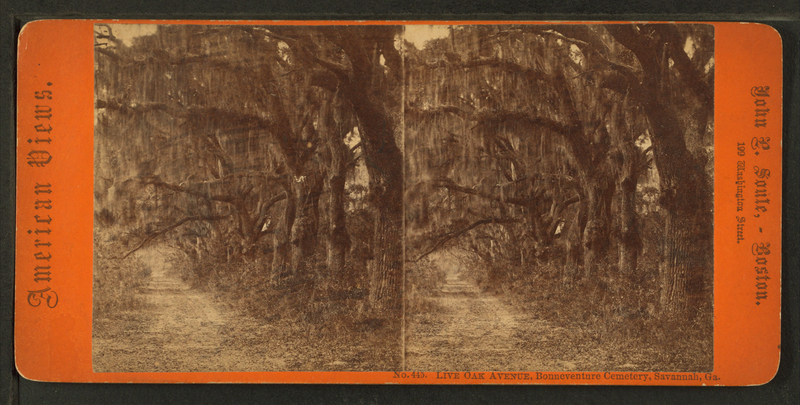Historic trees in Savannah GA
 |
| Bonaventure Cemetery (Image by reynolds.james.e) |
Should I have the opportunity to travel to Savannah, Georgia, I want to visit the Bonaventure Cemetery. It is known for its beautiful live oaks (Quercus virginiana) and for being the burial place of Johnny Mercer and Conrad Aiken. I've been curious about it ever since reading Midnight in the Garden of Good and Evil.
Bonaventure Cemetery overlooks the Wilmington River. The site was once part of a 600 acre farm named Bonaventure, established in 1762 by Colonel John Mullryne and his wife Claudia. Colonel Mullryne laid out an internal road system for the property and planted live oaks at close intervals along the roadsides. Some of these roadways today are the famous "oak alleys" of Bonaventure Cemetery.
 |
| An antique stereoscopic view of an oak alley at Bonaventure Cemetery. Image from Wikimedia Commons |
A family cemetery was established in the 1790s by a later owner of the plantation, Josiah Tattnall. The Tattnall family sold the plantation in 1846 to Peter Wiltberger. The Wiltbergers opened a 70-acre public cemetery (Evergreen Cemetery) on the property and assumed care of the original Tattnall burying ground (Old Bonaventure Cemetery). Evergreen Cemetery was taken over by the city of Savannah in 1907. The entire site, now 160 acres, is known as Bonaventure Cemetery today.
Donald Grant Mitchell wrote about Bonaventure Cemetery in Rural Studies: With Hints for Country Places. This book was published in 1867, so the live oaks were probably about 100 years old at the time of his visit.
Near to Savannah, in Georgia, and upon one of the creeks making into the irregular shores thereabout, is a cemetery called, if I remember rightly, Buena Ventura. In old times, any visitor at the Pulaski used to find his way there, and was richly repaid for the visit.
There was no proper "keeping" to the grounds. You passed in under a lumbering old gateway of unhewn timber; the paths were not carefully tended; there was much of rampant and almost indecorous undergrowth; the tombs were mossy, and the graves, many of them, sunken; but great liveoaks over-reached your path, and from their gnarled limbs hung swaying pennants of that weird gray moss of the Southern swamp lands—festooned, tangled, streaming down—now fluttering in a light breeze, and again drooping, as if with the weight of woe, to the very earth.
There was something mysteriously solemn and grave-like in it. The gnarled oaks and the slowly swaying plumes of gray told the completest possible story of the place. Had there been no tombs there, you would have said that it was the place of places where tombs should lie and the dead sleep. I have alluded to the scene only to show what and how much may be done by foliage and tree limbs, with their investing mosses, to give character to such a spot. (Source)
In A Thousand Mile Walk to the Gulf, John Muir recalled the days he spent camping in the Bonaventure Cemetery in 1867 while he was waiting in Savannah for money to arrive. Of the live oaks, he wrote:
The most conspicuous glory of Bonaventure is its noble avenue of live-oaks. They are the most magnificent planted trees I have ever seen, about fifty feet high and perhaps three or four feet in diameter, with broad spreading leafy heads. The main branches reach out horizontally until they come together over the driveway, embowering it throughout its entire length, while each branch is adorned like a garden with ferns, flowers, grasses, and dwarf palmettos.
But of all the plants of these curious tree-gardens the most striking and characteristic is the so-called Long Moss (Tillandsia usneoides). It drapes all the branches from top to bottom, hanging in long silvery-gray skeins, reaching a length of not less than eight or ten feet, and when slowly waving in the wind they produce a solemn funereal effect singularly impressive. (Source)
 |
| Live oaks at Bonaventure Cemetery, early 1900s. Library of Congress, Prints and Photographs Division, Detroit Publishing Company Collection. |
 |
| Bonaventure Cemetery Image by bp6316 is BACK |
The Savannah Department of Cemeteries reports that the live oaks have been in "slow decline" for the last century, after surviving a number of major hurricanes during the 1800s. I hope that some younger live oaks are growing so the unique atmosphere and beauty of Bonaventure Cemetery is preserved for future generations.
Further reading
Quercus virginiana
Live Oak, USDA Forest Service Sylvics Manual
Floridata: Quercus virginiana
Discover the Bonaventure Cemetery
Bonaventure Cemetery, Savannah
Great post... glad to see you're back blogging.
ReplyDeleteEnjoyed reading all the information on the Savannah cemetery. -- barbara
ReplyDeleteThank you for this wonderful post. I've just stumbled across your blog and am very much enjoying your tree notes.
ReplyDelete